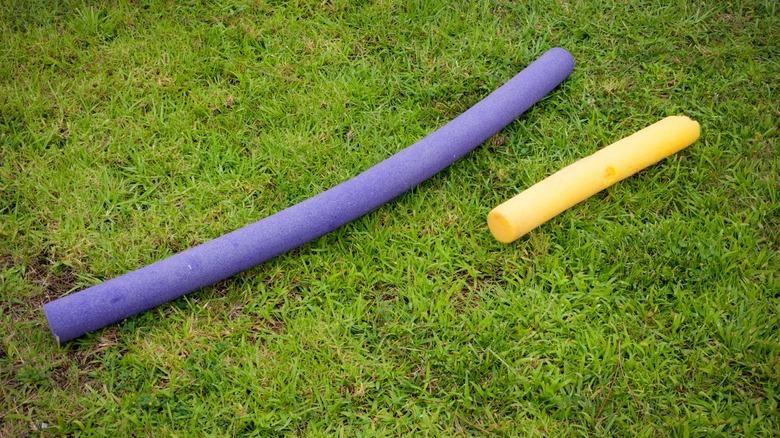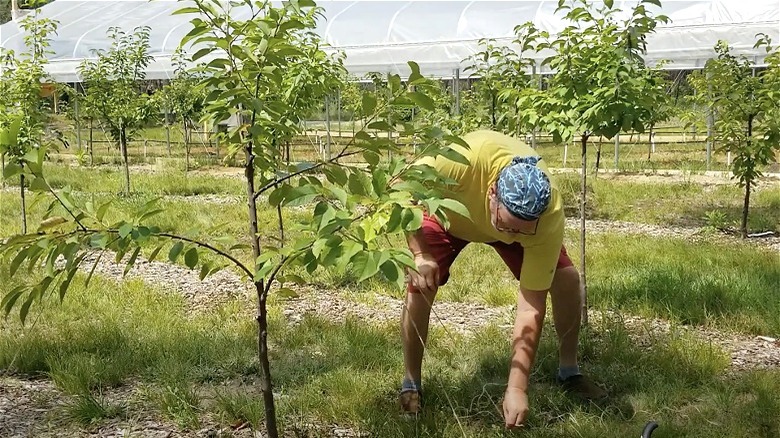This Pool Noodle Hack May Be The Key To Easily Training Tree Branches
Trees are fantastic additions to any home. They provide shade, attract birds, and can even offer fresh fruit. However, managing tree branches can be a bit tricky. You might find some branches growing too upright and wish they'd spread out, or perhaps they're hanging too low, and you want them more upright. People use different hacks and methods to direct or "train" their tree branches. TikTok user artsy.gardener has a clever hack: using pool noodles. Turns out, pool noodles aren't just for keeping your home clean and organized — they're also great for spacing tree branches. In the video, artsy.gardener demonstrates using pieces of pool noodles to keep branches from growing into each other.
Training young tree branches involves directing a branch in the direction you want. The key is to keep a branch in a particular position for a few months. Soon, the branch will follow this new direction as it grows. This hack is handy for helping drooping branches grow more upright. It's also a great hack if you want to create an "open" tree, particularly if yours yields fruits. This shape lets more sunlight reach the branches, promoting the growth of healthier leaves and buds and improving fruit quality. This also increases airflow to the branches, which reduces the risk of fungal infections and air-borne diseases by removing excess moisture. Practically speaking, horizontally growing branches make it easier to reach and harvest the fruits.
How to do the pool noodle hack (and is it ideal?)
To begin, all you need is a piece of pool noodle and a tool that can best cut it. While the TikTok video by artsy.gardener shows a hollow pool noodle, opting for a solid one can provide a firmer hold on the branches. Start by cutting the noodle lengthwise and then cut it into the size you need. Next, make a slit at either end of your cut piece, and slide it between the two branches you want to separate. This setup encourages the branches to grow apart, helping to prevent them from crowding each other and competing for space. You can also place a pool noodle between a sturdy branch to push one branch more horizontally.
Using pool noodles can effectively separate branches and position one at a desired angle, provided the other branch is sturdy enough to maintain its position. However, this method might not be ideal if both branches lack sturdiness, as it relies on placing the noodle between them. This can lead to one branch being positioned well while potentially pushing the other into an unfavorable angle. Thus, while it's great for preventing branches from intertwining, it might not allow for precise control over each branch's growth direction. If you're looking for more ways to use a pool noodle in your garden, why not use it to line the edges of your planters or produce endless tomato plants in your garden?
Alternatives for training tree branches
Tree growers and gardeners use many methods to train branches. For instance, Garden Fundamentals uses a makeshift weighted hook using concrete molded from a small drinking cup. He hooks this weight to a branch to straighten it. You can also take inspiration from Edible Backyard and use some ties to pull the branches down. It's important to tie these soft ties loosely around the branches to avoid restricting their circulation. Then, pull the tie to position the branches at the ideal angle, securing the other end to another branch or anchoring it to the ground with a rock or stake. This technique allows for precise control over the growth direction of the branches. If you want to pull branches upwards, you may need to use external structures like a stake or a nearby pole or fence.
You can also use clothespins as a simple and effective tool for training tree branches. For instance, clamping a clothespin above a shoot can help guide its growth downward. Clothespins can even serve as weights to manipulate branch direction. If you're dealing with sturdy branches that you want to train to grow more horizontally, consider creating a DIY branch spreader similar to what Edge of Nowhere Farm did for his pear tree. Cut a PVC pipe to size and place an elbow joint at each end. This setup makes it easier to attach the pipe securely to the branches, effectively spreading them apart for a more horizontal growth pattern.

